IN recent years,there has been an increasing interest in understanding the properties of networked multi-agent systems,which refer to systems of several subunits that exchange information in an effort to perform and carry out a collective task in a decentralized way. It is important to understand the way how these subsystems manage to accomplish a collective behavior, as such phenomena are observed in nature. A large and growing number of researches have been concerned with coordination control of networked multi-agent systems,e.g.,consensus[1, 2, 3, 4, 5, 6, 7], formation control[8, 9, 10, 11],rendezvous[12, 13],coverage control[14, 15] and flocking[16, 17] (more details are referred to [18, 19, 20]),partly due to the wide applications of multi-agent systems.
At present,relevant applications utilizing containment control, one type of coordination control,are widespread,e.g., multi-robot systems and expedition. The study of containment control problems is motivated by numerous natural phenomena and potential applications. For example,the male silkworm moths will end up in the convex hull spanned by all the female silkworm moths by detecting pheromone released by females; a group of heterogeneous robots move from one target to another. Some of the robots do not have the sensing capability to detect obstacles or other robots,while some of the robot team members are highly capable robots that could help to navigate the less capable robots,then a workable strategy would be that the more capable robots guide the less capable robots to deployment positions. Containment control strategies have been investigated a lot[21, 22, 23, 24, 25, 26, 27, 28, 29, 30],all of which used traditional approaches.
Sliding mode control is one of the most important approaches in the field of automatic control,and has been widely used in many applications,such as robots,aircrafts,motors,etc. In the multi-agent field,this approach has also drawn some researchers$'$ attention. In [31],distributed coordinated tracking problems of multi-agent systems with single-/double-integrator dynamics were proposed and analyzed, where there exists a dynamic virtual leader who is the neighbor of only a subset of a group of followers,all the followers have only local interaction,and only partial measurements of the states of the virtual leader and followers are available. In [32], distributed asymptotic consensus tracking control for linear multi-agent systems with a leader of bounded unknown input was considered. Undirected topologies were considered in all the results above. However,in practice,the network topology might be directed. In addition, the existing terminal sliding mode control may not deliver the same convergence performance when the system state is far away from equilibrium,albeit its finite time convergence lies in its exponentially growing convergence rate when the state is near equilibrium. To get a faster convergence rate,the study on distributed exponential finite time coordination control is necessary.
Motivated by the above discussion,the objective of this paper is to address the following issues. Firstly,under what conditions,a sliding mode control algorithm can be developed to guarantee that the followers converge to the convex hull spanned by the leaders in a finite time exponentially? Secondly,how to design this exponential finite time control algorithm systematically? The main contributions of this paper are listed as follows.
1) A coordination control scheme for multiple linear systems in a general form is studied. Multiple sliding variables are proposed such that all the error trajectories exponentially reach the sliding surfaces in a finite time and then the states of the followers asymptotically converge to the convex hull spanned by the leaders whose control inputs are nonzero and not available to any followers.
2) For both cases of reduced order and non-reduced order, multiple-surface sliding control laws are systematically developed to guarantee the achievement of containment control.
3) The control Lyapunov function for containment control, motivated by the fast terminal sliding mode control,is used to prove reachability of the sliding mode surfaces.
The outline of this paper is as follows. We establish some of the basic notations that will be used in the paper next. In Section Ⅱ, we list some basic definitions and results. We provide convergence analysis of the underlying network model which can be reduced to the regular form in Section Ⅲ,and the model which cannot be reduced to the regular form in Section Ⅳ,respectively. In Section V,we give some simulation results. Finally,we make a conclusion in Section Ⅵ.
Notation. Let 0 or 0m×n denote an all-zero vector or matrix with compatible dimension,or with the dimension of $m\times n$. $I_n$ is the $n\times n$ identity matrix. 1n represents the $n$-dimensional vector with all the entries being $1$. ${\bf R}^N$ and ${\bf R}^{N\times N}$ represent $N$-dimensional real vector space and the set of all the $N\times N$ real matrices,respectively. Let $\lambda(A)$ denote one of the eigenvalues of matrix $A$. $\mbox{sig}(x)^{\gamma}=\mbox{sgn}(x)|x|^{\gamma} =[\mbox{sgn}(x_1)|x_1|^{\gamma}, \mbox{sgn}(x_2)|x_2|^{\gamma},\cdots$,$ \mbox{sgn}(x_n)|x_n|^{\gamma}]^{\rm T}$,where $\mbox{sgn}(\cdot)$ is the signum function,
| $ \mbox{sgn}(x)=\left\{ \begin{array}{lllll}\ \ \ 1,\ \ x>0,\\ \ \ \ 0,\ \ x=0,\\ \,-1,\ \ x<0, \end{array} \right.$ |
and |·| is the absolute value of real numbers. For vector $\pmb{\omega}=[\omega_1,\omega_2,\cdots,\omega_n]^{\rm T}$,let $\omega_{\min}$ and $\omega_{\max}$ denote the minimum and maximum values of $\{\omega_1,\omega_2,\cdots,\omega_n\}$,respectively.
Ⅱ. SOME PRELIMINARIESIn this section,we present some definitions and results that will be used in this paper.
Directed graph will be used to model the communication topology between agents[33]. Let ${\mathcal G}=({\mathcal V}(\mathcal{G}),{\mathcal E}(\mathcal{G}),{\mathcal A}(\mathcal{G}))$ be a directed graph with the set of vertices ${\mathcal V}(\mathcal{G})=\{ v_1,v_2, \cdots,v_n \}$ and the set of edges $\mathcal E(\mathcal{G}) \subseteq \{(v_i,v_j): v_i,v_j \in \mathcal{V}(\mathcal{G})\}$, where an edge is an ordered pair of vertices in $\mathcal{V}(\mathcal{G})$,and the weighted adjacency matrix ${\mathcal A}(\mathcal{G})=[a_{ij}]$ with nonnegative adjacency elements $a_{ij}$. An edge of ${\mathcal G}$ is denoted by $e_{ij}=(v_j,v_i)$,where $v_j$ is the parent vertex of $v_i$, and $v_i$ is the child vertex of $v_j$. The adjacency elements associated with the edges are positive,i.e.,$e_{ij}\in{\mathcal E}(\mathcal{G})$ $\Leftrightarrow$ $a_{ij}>0$. Moreover,we assume $a_{ii}=0$ for all $v_i\in{\mathcal V}(\mathcal{G})$. The set of neighbors of node $v_i$ is denoted by ${\mathcal N}_i=\{v_j\in{\mathcal V}(\mathcal{G}):\,(v_j,v_i)\in{\mathcal E}(\mathcal{G}),~j\neq i\}$.
A directed path in a directed graph $\mathcal{G}$ is a sequence of vertices,$v_{i_1},\cdots,v_{i_k}$,such that $(v_{i_s}, v_{i_{s+1}}) \in \mathcal{E}(\mathcal{G})$ for $s=1,\cdots,k-1$. A directed graph $\mathcal{G}$ is strongly connected,if between every pair of distinct vertices $v_i,v_j$ in $\mathcal{G}$,there is a directed path that begins at $v_i$ and ends at $v_j$ (from $v_i$ to $v_j$).
Lemma 1[34]. Let $A\in {\bf C}^{n\times n}$ and $A\geq 0$. Then $A$ is irreducible if and only if the directed graph $\mathcal{G}(A)$ is strongly connected.
The Laplacian matrix $L=[l_{ij}]\in {\bf R}^{n \times n}$ of ${\mathcal G}$ is defined as
| $l_{ij}=\left\{\begin{array}{ll}-a_{ij},\ \ \ \ \ \ \ \ \ \ \ \ i\neq j,\\ \sum\limits_{k=1,k\neq i}^n a_{ik},\ \ \ \ \ i=j.\end{array}\right.$ |
The degree of node $v_i$ is given by $ \mbox{deg}(v_i)=\sum_{v_j\in \mathcal{N}_i}a_{ij}$. The degree matrix is an $n\times n$ matrix defined as $D=[d_{ij}]$, where $d_{ij}=\mbox{deg}(v_i)$ for $i=j$,otherwise,$d_{ij}=0$. Then the Laplacian of the graph $\mathcal{G}$ can be written as $ L=D-\mathcal{A}(\mathcal{G})$.
Lemma 2[35]. A complex matrix $ M=[m_{ij}] \in {\bf C}^{n\times n}$ is nonsingular,if $M$ is irreducible and $|m_{ii}|\geq \sum_{j\neq i}|m_{ij}|$ for all $i$ with the inequality strict for at least one $i$.
Definition 1[36]. Communication topology $\mathcal{G}$ is said to satisfy the detail-balanced condition in weights,if there exist some scalars $\omega_i>0$,$i=1,2,\cdots,n$,such that $\omega_j a_{ij}=\omega_i a_{ji}$ for all $i,j=1,2,\cdots, n$.
Lemma 3. Suppose there exists continuously differentiable Lyapunov function $V: \mathcal{D} \rightarrow {\bf R}_{\geq 0}$ with respect to $x(t)$ in an open neighborhood $\mathcal{D}\subset {\bf R}^n$ of the origin, real constants $\alpha,\beta >0$,and rational numbers $p,q$ in the form of $\frac{{2m + 1}}{{2n + 1}},\:m < n$ and $m,n \in {{\bf{Z}}^ + } \cup \{ 0\} $ such that for all $t\geq t_0$,
| $\dot V(x(t)) \le - \alpha V(x(t)) - \beta V{(x(t))^{\frac{p}{q}}},\;\;\,x(t) \in {\cal D}\backslash \{ 0\} .$ | (1) |
Then $V(x(t))$ will exponentially reach zero in finite time
| $T(x(t_0))=t_0+\frac{q}{\alpha(q-p)}\ln \frac{\alpha V(x(t_0))^{\frac{q-p}{q}}+\beta}{\beta}$. |
Proof. The result can be derived immediately by considering the solution of nonlinear system
| $\label{eqn:improve} \dot{x}(t)=-\alpha x(t) -\beta \mbox{sig}(x(t))^{\frac{p}{q}}.$ | (2) |
The solution of (2) is given below:
| $x(t) = \left\{ {\begin{array}{*{20}{l}} {{\rm{sgn}}(x({t_0})){{[(|x({t_0}){|^{\frac{{q - p}}{q}}} + \frac{\beta }{\alpha }){{\rm{e}}^{ - \frac{{\alpha (q - p)}}{q}(t - {t_0})}} - \frac{\beta }{\alpha }]}^{\frac{q}{{q - p}}}},}\\ {\:\:\:\:\:\:\:\:\:\:\:\:t < {t_0} + \frac{q}{{\alpha (q - p)}}\ln \frac{{\alpha |x({t_0}){|^{\frac{{q - p}}{q}}} + \beta }}{\beta },\:\:x \ne 0,}\\ {0,\:\:\:\:\:\:\:\:t \ge {t_0} + \frac{q}{{\alpha (q - p)}}\ln \frac{{\alpha |x({t_0}){|^{\frac{{q - p}}{q}}} + \beta }}{\beta },\:\:\:\;x \ne 0,}\\ {0,\:\:\:\:\:\:\:\:t \ge 0,\:\:\:\:\:\:\:\:\:\:\:\:\:\:\:\:\:\:\:\;\;\;\;\;\;\;\;\:\:\:\:\:\:\:\:\:\:\:\:\:\:\:\;\:\:x = 0.} \end{array}} \right.$ | (3) |
Definition 2[37]. A set $K\subset {\bf R}^{m}$ is said to be convex if $(1-\gamma )x+\gamma y \in K$ whenever $x\in K$,$y\in K$ and $0<\gamma <1$. The convex hull of a finite set of points $x_1, \cdots,x_n \in {\bf R}^m$ is the minimal convex set containing all points $x_i,i=1,\cdots,n$,denoted by $\mbox{co}\{x_1, \cdots,x_n\}$. Particularly,$\mbox{co}\{x_1,\cdots, x_n\}=\{\sum_{i=1}^n \alpha_i x_i:\alpha_i \in {\bf R},~ \alpha_i\geq 0,~ \sum_{i=1}^n \alpha_i=1\}$.
We start with the conventional problem of linear control theory. Suppose that all the agents share a common state space ${\bf R}^N$. Let $x_i(t)\in {\bf R}^N$ denote the state of agent $i$ which needs to be coordinated,then the dynamics of agent $i$ can be described by
| $\label{eqn:dynamics} \dot{x}_i(t) =A x_i(t)+B u_i(t),\ i=1,2,\cdots,n,$ | (4) |
where $A\in {\bf R}^{N\times N}$,$B\in {\bf R}^{N\times M}$ are constant matrices,$\mbox{rank}(B)=M$,and $u_i(t)\in {\bf R}^M$ is the control protocol,which can be designed according to the state information available to agent $i$. The system is assumed to be controllable.
Definition 3[25]. For an $n$-agent system,an agent is called a leader if the agent has no neighbor,and a follower if the agent has at least one neighbor.
In this paper,we assume that there are $m$ ($m < n$) leaders and $n-m$ followers. We denote the set of leaders as $\mathcal{R}$ and the set of followers as $\mathcal{F}$.
According to the definitions of leader and follower,$L$ can be partitioned as[28]
| $\left[\begin{array}{ccccc}L_{\mathcal{F}\mathcal{F}} L_{\mathcal{F}\mathcal{R}}\\ \mathbf{0}_{m\times(n-m)} \mathbf{0}_{m\times m} \end{array}\right],$ | (5) |
where $L_{\mathcal{F}\mathcal{F}} \in {\bf R}^{(n-m)\times (n-m)}$ and $L_{\mathcal{F}\mathcal{R}}\in {\bf R}^{(n-m)\times m}$.
It is obvious that $L_{\mathcal{F}\mathcal{F}}=L(\mathcal{G}(\mathcal{F}))+\Delta$, where $\Delta= \mbox{diag}\{\Delta_1,\Delta_2,\cdots, \Delta_{n-m}\}\in {\bf R}^{(n-m)\times (n-m)}$ is a diagonal matrix with all the entries are non-negative. Specifically, $\Delta_i>0$,if the $i$th follower can receive the information from one of the leaders directly,and otherwise,$\Delta_i=0$. According to the proof of Theorem 1 in [28],we know that all the entries of $-L_{\mathcal{F}\mathcal{F}}^{-1}L_{\mathcal{F}\mathcal{R}}$ are non-negative and $-L_{\mathcal{F}\mathcal{F}}^{-1}L_{\mathcal{F}\mathcal{R}}\mathbf{1}_m=\mathbf{1}_{n-m}$.
In the two following sections,we will study containment control of multi-agent systems by using the fast sliding mode approach for the reduced order case and the non-reduced order case, respectively.
Ⅲ. Reduced order caseIn this section,we will study containment control of the multi-agent system which can be reduced to the regular form,and show that the containment control problem may be solved in the framework of sliding mode control dealing with a reduced order system. Since $\mbox{rank}(B)=M$,matrix $B$ may be partitioned (after reordering the state vector components) as
| $B=\left[\begin{array}{cccc}B_1\\ B_2\end{array}\right],$ |
where $B_1 \in {\bf R}^{(N-M)\times M}$,$B_2\in {\bf R}^{M\times M}$ with $\det (B_2) \neq 0$. The nonsingular coordinate transformation,
| $\left[\begin{array}{cccc}x_{1i}(t)\\ x_{2i}(t)\end{array}\right]= Tx_i(t), \ \ T=\left[\begin{array}{ccccc}I_{N-M} & -B_1 B_2^{-1} \\ \mathbf{0} & B_2^{-1}\end{array}\right],$ |
reduces system (4) to the regular form of
| $\label{eqn:regular} \left[\begin{array}{lllll} \dot{x}_{1i}(t)\\ \dot{x}_{2i}(t) \end{array}\right]=\left[\begin{array}{cccc}A_{11} & A_{12}\\ A_{21} &A_{22}\end{array}\right]\left[\begin{array}{cccc}x_{1i}(t)\\ x_{2i}(t)\end{array}\right]+ \left[\begin{array}{ccc}\mathbf{0}\\ I_M\end{array}\right]u_i(t),$ | (6) |
where $x_{1i}(t)\in {\bf R}^{N-M}$,$x_{2i}(t)\in {\bf R}^M$,and $A_{ij}$ are constant matrices ($i,j=1,2$).
We can observe that $x_{1i}(t)$ in (6) is free of the control input $u_i(t)$ which can only influence the dynamics of $x_{2i}(t)$. The problem of the desired eigenvalue allocation for the original multi-agent system can be transformed after defining the sliding mode motion. The following lemma characterizes this property.
Lemma 4[38]. If the pair $(A,B)$ is controllable,the pair $(A_{11},A_{12})$ is also controllable.
We list the dynamics of followers and leaders separately in the following:
| $\begin{array}{l} {{\dot x}_{1{\cal F}}}\left( t \right) = ({I_{n - m}} \otimes {A_{11}}){x_{1{\cal F}}}\left( t \right) + ({I_{n - m}} \otimes {A_{12}}){x_{2{\cal F}}}\left( t \right),\\ {{\dot x}_{2{\cal F}}}\left( t \right) = ({I_{n - m}} \otimes {A_{21}}){x_{1{\cal F}}}\left( t \right) + ({I_{n - m}} \otimes {A_{22}}){x_{2{\cal F}}}\left( t \right) + {u_{\cal F}}\left( t \right),\\ {{\dot x}_{1{\cal R}}}\left( t \right) = ({I_m} \otimes {A_{11}}){x_{1{\cal R}}}\left( t \right) + ({I_m} \otimes {A_{12}}){x_{2{\cal R}}}\left( t \right),\\ {{\dot x}_{2{\cal R}}}\left( t \right) = ({I_m} \otimes {A_{21}}){x_{1{\cal R}}}\left( t \right) + ({I_m} \otimes {A_{22}}){x_{2{\cal R}}}\left( t \right) + {u_{\cal R}}\left( t \right). \end{array}$ |
Here,we assume that all the leaders have the same input,i.e., $u_{\mathcal{R}}(t)=\mathbf{1}_m \otimes u_0(t)$,where $u_0(t)\in {\bf R}^M$,to guarantee that the shape of the convex hull spanned by the leaders is time-invariant.
By handling $x_{2i}(t)$ as an $M$-dimensional intermediate control in the first controllable subsystem of (6) with the dimension of $N-M$ and choosing proper matrix $K\in {\bf R}^{M\times (N-M)}$, the eigenvalues of $A_{11}$ may be assigned arbitrarily. That is, by choosing proper feedback gain matrix $K$ in
| $x_{2i}(t)=-Kx_{1i}(t),$ | (7) |
we can obtain the expected properties of $x_{1i}(t)$.
Lemma 5. If the pair $(A,B)$ is controllable,then,by choosing an appropriate matrix $K$,the eigenvalues of matrix in the sliding mode equation
| $\label{aftersliding} \dot{\tilde{x}}_1(t)=I_{N-M}\otimes (A_{11}-A_{12}K) \tilde{x}_1(t),$ | (8) |
where $\tilde{x}_{1}(t)=x_{1\mathcal{F}}(t)-(-L_{\mathcal{F}\mathcal{F}}^{-1}L_{\mathcal{F}\mathcal{R}})\otimes I_{N-M} x_{1\mathcal{R}}(t)$,may be arbitrarily placed.
We enforce the sliding mode in the manifold
| $s_{i\in\mathcal{F}}=\!\!\!\!\sum_{j\in \mathcal{F}\cup \mathcal{R}}\!\!\!a_{ij}( x_{2i}(t)-x_{2j}(t))+K(\!\!\sum_{j\in \mathcal{F}\cup \mathcal{R}}\! \!a_{ij}( x_{1i}(t)-x_{1j}(t))),$ |
and its matrix form is
| $\begin{array}{l} s = ({L_{{\cal F}{\cal F}}} \otimes {I_M}){x_{2{\cal F}}}(t) + ({L_{{\cal F}{\cal R}}} \otimes {I_M}){x_{2{\cal R}}}(t) + \\ ({L_{{\cal F}{\cal F}}} \otimes K){x_{1{\cal F}}}(t) + ({L_{{\cal F}{\cal R}}} \otimes K){x_{1{\cal R}}}(t) = \\ ({L_{{\cal F}{\cal F}}} \otimes {I_M})({x_{2{\cal F}}}(t) + ((L_{{\cal F}{\cal F}}^{ - 1}{L_{{\cal F}{\cal R}}}) \otimes {I_M}){x_{2{\cal R}}}(t)) + \\ ({L_{{\cal F}{\cal F}}} \otimes K)({x_{1{\cal F}}}(t) + ((L_{{\cal F}{\cal F}}^{ - 1}{L_{{\cal F}{\cal R}}}) \otimes {I_M}){x_{1{\cal R}}}(t)). \end{array}$ |
After sliding mode starts,the motion is governed by the reduced-order system (8). Because of controllability of $(A_{11},A_{12})$,we can find a control gain matrix $K=A_{12}^{\rm T} P$,where $P$ is the unique solution of the following algebraic Riccati equation[39]
| $\label{eqn:Riccati1} A_{11}^{\rm T} P +PA_{11}+ I_N-PA_{12} A_{12}^{\rm T} P=0.$ | (9) |
We can rewrite (9) as $ (A_{11}-A_{12}A_{12}^{\rm T} P)^{\rm T} P +P(A_{11}-A_{12}A_{12}^{\rm T} P)+(I_N+PA_{12}A_{12}^{\rm T} P)=0,$ whereby we infer that $I_{N-M}\otimes (A_{11}-A_{12}A_{12}^{\rm T} P)$ is Hurwitz.
How can we bring the error trajectories to the manifold $s=0$ and maintain it there? The variable $s$ satisfies the equation
| $\begin{array}{l} \dot s = ({L_{{\cal F}{\cal F}}} \otimes {I_M}){{\dot x}_{2{\cal F}}} + ({L_{{\cal F}{\cal R}}} \otimes {I_M}){{\dot x}_{2{\cal R}}} + \\ ({L_{{\cal F}{\cal F}}} \otimes K){{\dot x}_{1{\cal F}}} + ({L_{{\cal F}{\cal R}}} \otimes K){{\dot x}_{1{\cal R}}} = \\ ({L_{{\cal F}{\cal F}}} \otimes {I_M})(({I_{n - m}} \otimes {A_{21}}){x_{1{\cal F}}} + ({I_{n - m}} \otimes {A_{22}}){x_{2{\cal F}}} + \\ {u_{\cal F}}(t)) + ({L_{{\cal F}{\cal R}}} \otimes {I_M})(({I_m} \otimes {A_{21}}){x_{1{\cal R}}} + \\ ({I_m} \otimes {A_{22}}){x_{2{\cal R}}} + {{\bf{1}}_m} \otimes {u_0}(t)) + \\ ({L_{{\cal F}{\cal F}}} \otimes K)(({I_{n - m}} \otimes {A_{11}}){x_{1{\cal F}}} + ({I_{n - m}} \otimes {A_{12}}){x_{2{\cal F}}}) + \\ ({L_{{\cal F}{\cal R}}} \otimes K)(({I_m} \otimes {A_{11}}){x_{1{\cal R}}} + ({I_m} \otimes {A_{12}}){x_{2{\cal R}}}) = \\ ({L_{{\cal F}{\cal F}}} \otimes ({A_{21}} + K{A_{11}})({x_{1{\cal F}}} + (L_{{\cal F}{\cal F}}^{ - 1}{L_{{\cal F}{\cal R}}} \otimes {I_{N - M}}){x_{1{\cal R}}}) + \\ ({L_{{\cal F}{\cal F}}} \otimes ({A_{22}} + K{A_{12}})({x_{2{\cal F}}} + (L_{{\cal F}{\cal F}}^{ - 1}{L_{{\cal F}{\cal R}}} \otimes {I_M}){x_{2{\cal R}}}) + \\ ({L_{{\cal F}{\cal F}}} \otimes {I_M}){u_{\cal F}}(t) + ({L_{{\cal F}{\cal R}}}{{\bf{1}}_m}) \otimes {u_0}(t). \end{array}$ |
Letting $ H= L_{\mathcal{F}\mathcal{F}}\Xi$,from Lemma 1,Lemma 2 and the definition of detail-balanced condition,we obtain that $H$ is a positive definite symmetric matrix. The protocol is designed as
| ${u_{i \in {\cal F}}}(t) = - {\rm{sgn}}({s_i})(\alpha ||\sum\limits_{j \in {\cal F} \cup {\cal R}} {{a_{ij}}} ({x_i}(t) - {x_j}(t))|{|_1} + \delta ) - \beta {s_i},$ | (10) |
which can be written in the matrix form of
| $\begin{array}{l} {u_{\cal F}}(t) = - {\rm{sgn}}(s)(\alpha ||({L_{{\cal F}{\cal F}}} \otimes {I_N}){x_{\cal F}}(t) + \\ \,({L_{{\cal F}{\cal R}}} \otimes {I_N}){x_{\cal R}}(t)|{|_1} + \delta ) - \beta s. \end{array}$ |
Theorem 1. Suppose that the fixed followers$'$ subgraph $\mathcal{G}$ is strongly connected and satisfies detail-balanced condition. For each follower,there exists at least one leader who has a directed path to the follower. Using the fast sliding mode control protocol (10) for system (4),if $\| u_0\|_{\infty}<\frac{\delta (\omega_i^{-1})_{\min}}{(\omega_i^{-1})_{\max}}$ and $\alpha$ is sufficiently large,then all the error trajectories exponentially reach the manifold $s=0$ in a finite time $ T_1=\frac{\lambda_{\max}(H^{-1})}{\beta (\omega_i^{-1})_{\min}}\ln(\frac{\sqrt{2}\beta (\omega_i^{-1})_{\min} V(0)^{\frac{1}{2}}}{\sqrt{\lambda_{\max}(H^{-1})}(\delta (\omega_i^{-1})_{\min}-(\omega_i^{-1})_{\max}\|u_0(t)\|_{\infty})}+1)$ followed by a sliding phase during which the followers asymptotically converge to the convex hull spanned by the leaders.
Proof. Calculating the time derivative of the positive definite Lyapunov function
| $V=\frac{1}{2}s^{\rm T}(H^{-1}\otimes I_M)s,$ |
we have
| $\begin{array}{l} \dot V = {s^{\rm{T}}}(({\Xi ^{ - 1}} \otimes ({A_{21}} + K{A_{11}}))({x_{1{\cal F}}} + (L_{{\cal F}{\cal F}}^{ - 1}{L_{{\cal F}{\cal R}}} \otimes {I_{N - M}}){x_{1{\cal R}}}) + \\ ({\Xi ^{ - 1}} \otimes ({A_{22}} + K{A_{12}}))({x_{2{\cal F}}} + (L_{{\cal F}{\cal F}}^{ - 1}{L_{{\cal F}{\cal R}}} \otimes {I_M}){x_{2{\cal R}}}) + \\ ({\Xi ^{ - 1}} \otimes {I_M})({u_{\cal F}}(t) + (L_{{\cal F}{\cal F}}^{ - 1}{L_{{\cal F}{\cal R}}}{{\bf{1}}_m}) \otimes {u_0}(t))) = \\ {s^{\rm{T}}}(({\Xi ^{ - 1}} \otimes ({A_{21}} + K{A_{11}}))({x_{1{\cal F}}} + (L_{{\cal F}{\cal F}}^{ - 1}{L_{{\cal F}{\cal R}}} \otimes {I_{N - M}}){x_{1{\cal R}}}) + \\ ({\Xi ^{ - 1}} \otimes ({A_{22}} + K{A_{12}}))({x_{2{\cal F}}} + (L_{{\cal F}{\cal F}}^{ - 1}{L_{{\cal F}{\cal R}}} \otimes {I_M}){x_{2{\cal R}}})) - \\ {s^{\rm{T}}}({\Xi ^{ - 1}} \otimes {I_M})({\rm{sgn}}(s)(\alpha \parallel ({L_{{\cal F}{\cal F}}} \otimes {I_N}){x_{\cal F}}(t) + \\ ({L_{{\cal F}{\cal R}}} \otimes {I_N}){x_{\cal R}}(t){\parallel _1} + \delta ) - \beta {s^{\rm{T}}}({\Xi ^{ - 1}} \otimes {I_M})s - \\ {s^{\rm{T}}}({\Xi ^{ - 1}} \otimes {I_M})({{\bf{1}}_{n - m}} \otimes {u_0}(t)) \le \\ \parallel s{\parallel _1}\parallel ({\Xi ^{ - 1}} \otimes ({A_{21}} + K{A_{11}}))({x_{1{\cal F}}} + (L_{{\cal F}{\cal F}}^{ - 1}{L_{{\cal F}{\cal R}}} \otimes {I_{N - M}}){x_{1{\cal R}}}) + \\ ({\Xi ^{ - 1}} \otimes ({A_{22}} + K{A_{12}}))({x_{2{\cal F}}} + (L_{{\cal F}{\cal F}}^{ - 1}{L_{{\cal F}{\cal R}}} \otimes {I_M}){x_{2{\cal R}}}){\parallel _1} - \\ \alpha {(\omega _i^{ - 1})_{\min }}\parallel s{\parallel _1}(\parallel ({L_{{\cal F}{\cal F}}} \otimes {I_N}){x_{\cal F}}(t) + ({L_{{\cal F}{\cal R}}} \otimes {I_N}){x_{\cal R}}(t){\parallel _1} - \\ \beta {s^{\rm{T}}}({\Xi ^{ - 1}} \otimes {I_M})s - (\delta {(\omega _i^{ - 1})_{\min }} - {(\omega _i^{ - 1})_{\max }}\parallel {u_0}(t){\parallel _\infty })\parallel s{\parallel _1}. \end{array}$ |
It is evident there exists a value $\alpha$ such that,for any $\frac{\delta (\omega_i^{-1})_{\min}}{(\omega_i^{-1})_{\max}} > \| u_0(t)\|_{\infty}$,the time derivative $\dot{V}$ is negative. Specifically,
| $\dot{V}\leq -\beta s^{\rm T}(\Xi^{-1}\otimes I_M) s- \\ (\delta (\omega_i^{-1})_{\min}-(\omega_i^{-1})_{\max}\|u_0(t)\|_{\infty})\|s\|_1 \leq \\ -\frac{2 \beta (\omega_i^{-1})_{\min}}{\lambda_{\max}(H^{-1})}V -\\ (\delta (\omega_i^{-1})_{\min}-(\omega_i^{-1})_{\max}\|u_0(t)\|_{\infty})\|s\|_2\leq \\ -\frac{2 \beta (\omega_i^{-1})_{\min}}{\lambda_{\max}(H^{-1})}V -(\delta (\omega_i^{-1})_{\min}-\\ (\omega_i^{-1})_{\max}\|u_0(t)\|_{\infty})\sqrt{\frac{2}{\lambda_{\max}(H^{-1})}}V^{\frac{1}{2}}.$ |
From Lemma 3,the error trajectories exponentially reach the manifold $s=0$ in a finite time. Once on the manifold,they cannot leave,as seen from the inequality $\dot{V}\leq -\frac{2 \beta (\omega_i^{-1})_{\min}}{\lambda_{\max}(H^{-1})}V -(\delta (\omega_i^{-1})_{\min}-(\omega_i^{-1})_{\max}\|u_0(t)\|_{\infty})\sqrt{\frac{2}{\lambda_{\max}(H^{-1})}}V^{\frac{1}{2}}$. We have $V(t)=0$ when $t\geq T_1$.
Ⅳ. NON-REDUCED ORDER CASEIn this section,we will study containment control of the multi-agent system which cannot be reduced to the regular form, and show that the containment control problem may be solved in the framework of sliding mode control dealing with a non-reduced order system.
For the controllable pair $(A,B)$,the following algebraic Riccati equation[39]
| $\label{eqn:Riccati} A^{\rm T} P +PA+ I_N-PB B^{\rm T} P=0$ | (11) |
has the unique solution $P=P^{\rm T}>0$.
We rewrite the dynamics of leaders and followers in a separate form as
| $\dot{x}_{\mathcal{F}}(t)=(I_{n-m}\otimes A)x_{\mathcal{F}}(t)+(I_{n-m}\otimes B)u_{\mathcal{F}}(t),\\ \dot{x}_{\mathcal{R}}(t)=(I_{m}\otimes A)x_{\mathcal{R}}(t)+(\mathbf{1}_m\otimes ( B u_0(t))).$ |
If the system is not reduced to the regular form,we define the manifold as
| $s_{i\in \mathcal{F}}=\sum_{j\in \mathcal{F} \cup \mathcal{R}}a_{ij}(x_i(t)-x_j(t)),$ |
and its matrix form is
| $\begin{array}{l} s = ({L_{{\cal F}{\cal F}}} \otimes {I_N}){x_{\cal F}}(t) + ({L_{{\cal F}{\cal R}}} \otimes {I_N}){x_{\cal R}}(t) = \\ ({L_{{\cal F}{\cal F}}} \otimes {I_N})({x_{\cal F}}(t) + ((L_{{\cal F}{\cal F}}^{ - 1}{L_{{\cal F}{\cal R}}}) \otimes {I_N}){x_{\cal R}}(t)). \end{array}$ |
Assuming that sliding mode in $s=0$ has the desired dynamics properties,we have
| $\begin{array}{l} \dot s = ({L_{{\cal F}{\cal F}}} \otimes {I_N})(({I_{n - m}} \otimes A){x_{\cal F}}(t) + ({I_{n - m}} \otimes B){u_{\cal F}}(t)) + \\ ({L_{{\cal F}{\cal R}}} \otimes {I_N})(({I_m} \otimes A){x_{\cal R}}(t) + {{\bf{1}}_m} \otimes (B{u_0}(t))) = \\ ({L_{{\cal F}{\cal F}}} \otimes A){x_{\cal F}}(t) + ({L_{{\cal F}{\cal F}}} \otimes B){u_{\cal F}}(t) + \\ ({L_{{\cal F}{\cal R}}} \otimes A){x_{\cal R}}(t) + ({L_{{\cal F}{\cal R}}}{{\bf{1}}_m}) \otimes (B{u_0}(t)) = \\ ({I_{n - m}} \otimes A)(({L_{{\cal F}{\cal F}}} \otimes {I_N}){x_{\cal F}}(t) + ({L_{{\cal F}{\cal R}}} \otimes {I_N}){x_{\cal R}}(t)) + \\ ({L_{{\cal F}{\cal F}}} \otimes B){u_{\cal F}}(t) + ({L_{{\cal F}{\cal R}}}{{\bf{1}}_m}) \otimes (B{u_0}(t)) = ({I_{n - m}} \otimes A)s + \\ ({L_{{\cal F}{\cal F}}} \otimes B){u_{\cal F}}(t) + ({L_{{\cal F}{\cal R}}}{{\bf{1}}_m}) \otimes (B{u_0}(t)). \end{array}$ |
The fast terminal sliding mode control protocol is designed as
| $\label{eqn:nonreduce-protocol} u_{\mathcal{F}i}(t)=-\alpha \mbox{sgn}( (B^{\rm T} P) s_i)-\beta B^{\rm T} P s_i,$ | (12) |
and its matrix form is
| $ u_{\mathcal{F}}(t)=-\alpha \mbox{sgn}((I_{n-m}\otimes B^{\rm T} P)s)-\beta (I_{n-m}\otimes B^{\rm T} P)s.$ | (13) |
Theorem 2. Suppose that the fixed followers$'$ subgraph $\mathcal{G}$ is strongly connected and satisfies detail-balanced condition. For each follower,there is at least one of the leaders who has a directed path to the follower. Using the fast sliding mode control protocol (12) for system (4),the followers exponentially converge to the convex hull spanned by the leaders in a finite time $T_2=\lambda_{\max}(P)\ln(\frac{\sqrt{2 \lambda_{\max}(H^{-1})}}{\lambda_{\max}(P)\lambda_{\min}(PBB^{\rm T} P)}V(0)^{\frac{1}{2}}+1)$ if $ \| u_{\mathcal{R}}\|_{\infty}<\frac{\alpha (\omega_i^{-1})_{\min}}{(\omega_i^{-1})_{\max}}$ and $\beta \lambda_i(\Xi L_{\mathcal{F}\mathcal{F}}\Xi^{-1})\geq\frac{1}{2}$ for all $i=1,2,\cdots,n$.
Proof. We choose the Lyapunov function as
| $V=\frac{1}{2}s^{\rm T} (H^{-1} \otimes P) s,$ | (14) |
and its time derivative is
| $\begin{array}{l} \dot V = \frac{1}{2}{s^{\rm{T}}}\left( {{H^{ - 1}} \otimes \left( {{A^{\rm{T}}}P + PA} \right)} \right)s - \\ \alpha {s^{\rm{T}}}\left( {{\Xi ^{ - 1}} \otimes PB} \right){\rm{sgn}}\left( {{I_{n - m}} \otimes \left( {{B^{\rm{T}}}P} \right)s} \right) - \\ \beta {s^{\rm{T}}}\left( {{\Xi ^{ - 1}} \otimes \left( {PB{B^{\rm{T}}}P} \right)} \right)s + \\ {s^{\rm{T}}}\left( {{\Xi ^{ - 1}} \otimes P} \right)\left( {\left( {L_{FF}^{ - 1}{L_{FR}}{{\bf{1}}_m}} \right) \otimes \left( {B{u_0}\left( t \right)} \right)} \right) = \\ \frac{1}{2}{s^{\rm{T}}}\left( {{H^{ - 1}} \otimes {I_N}} \right)\left( {{I_{n - m}} \otimes \left( {{A^{\rm{T}}}P + PA} \right)} \right. - \\ \left. {2\beta \left( {\Xi {L_{FF}}{\Xi ^{ - 1}}} \right) \otimes PB{B^{\rm{T}}}P} \right)s - \\ \alpha {s^{\rm{T}}}\left( {{\Xi ^{ - 1}} \otimes PB} \right){\rm{sgn}}\left( {{I_{n - m}} \otimes \left( {{B^{\rm{T}}}P} \right)s} \right) - \\ {s^{\rm{T}}}\left( {{\Xi ^{ - 1}} \otimes \left( {PB} \right)} \right)\left( {{{\bf{1}}_{n - m}} \otimes {u_0}\left( t \right)} \right) \le \\ - \frac{1}{2}{s^{\rm{T}}}\left( {{H^{ - 1}} \otimes {I_N}} \right)s - \left( {\alpha {{\left( {\omega _i^{ - 1}} \right)}_{\min }} - } \right.\\ \left. {{{\left( {\omega _i^{ - 1}} \right)}_{\max }}\parallel {u_R}\left( t \right){\parallel _\infty }} \right)\parallel \left( {{I_{n - m}} \otimes \left( {{B^{\rm{T}}}P} \right)} \right)s{\parallel _1} \le \\ - \frac{2}{{{\lambda _{\max }}\left( P \right)}}V - \left( {\alpha {{\left( {\omega _i^{ - 1}} \right)}_{\min }} - } \right.\\ \left. {{{\left( {\omega _i^{ - 1}} \right)}_{\max }}\parallel {u_R}\left( t \right){\parallel _\infty }} \right)\parallel \left( {{I_{n - m}} \otimes \left( {{B^{\rm{T}}}P} \right)} \right)s{\parallel _2} = \\ - \frac{2}{{{\lambda _{\max }}\left( P \right)}}V - \left( {\alpha {{\left( {\omega _i^{ - 1}} \right)}_{\min }} - } \right.\\ \left. {{{\left( {\omega _i^{ - 1}} \right)}_{\max }}\parallel {u_R}\left( t \right){\parallel _\infty }} \right)\sqrt {{s^{\rm{T}}}\left( {{I_{n - m}} \otimes PB{B^{\rm{T}}}P} \right)s} \le \\ - \frac{2}{{{\lambda _{\max }}\left( P \right)}}V - \left( {\alpha {{\left( {\omega _i^{ - 1}} \right)}_{\min }} - } \right.\\ \left. {{{\left( {\omega _i^{ - 1}} \right)}_{\max }}\parallel {u_R}\left( t \right){\parallel _\infty }} \right)\sqrt {\frac{{2{\lambda _{\min }}\left( {PB{B^{\rm{T}}}P} \right)}}{{{\lambda _{\max }}\left( {{H^{ - 1}}} \right){\lambda _{\max }}\left( P \right)}}} {V^{\frac{1}{2}}}. \end{array}$ |
For any $ \| u_{\mathcal{R}}\|_{\infty}<\frac{\alpha (\omega_i^{-1})_{\min}}{(\omega_i^{-1})_{\max}}$,the time derivative $\dot{V}$ is negative. From Lemma 3,$V$ will exponentially reach zero in a finite time $T_2$.
Ⅴ. SIMULATIONSIn this section,we present several simulation results to validate the previous theoretical results.
Example 1. We consider a group of six agents with two leaders,namely,nodes $1$ and $2$,and four followers,namely, nodes 3$\sim$6. The interaction pattern is chosen as Fig. 1. The numbers in the circles are the indices of agents,and the numbers near edges are weights. Clearly,the followers$'$ subgraph is strongly connected,and satisfies detail-balanced condition. We choose nodes $3$ and $5$ as the pinned nodes.
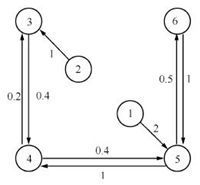
|
Download:
|
| Fig. 1. A directed graph with 2 leaders and 4 followers. | |
We assume that $A = \left[{\begin{array}{*{20}{c}} {01}\\ {00} \end{array}} \right]$,$B=\left[\begin{array}{cc}1\\ 1\end{array}\right]$. It is obvious that the pair $(A,B)$ is controllable. By some calculations,we can obtain the nonsingular coordinate transformation $T=\left[\begin{array}{ccc}1 -1\\ 0 1\end{array}\right]$. Then the matrix $A$ becomes $\left[\begin{array}{ccc}01\\00\end{array}\right]$,and the matrix $B$ becomes $\left[\begin{array}{cc}0\\ 1\end{array}\right]$. As a result,we have $A_{11}=0$,$A_{12}=1$, $A_{21}=0$ and $A_{22}=0$. From (9),we can obtain $P=1$. Therefore,matrix $K$ can be chosen as $K=B^{\rm T} P =1$. We choose $\alpha=2$,$\delta=3$,and $\beta=10$. The initial condition is chosen as $x_0=[1;8;2;0;-6;-4;8;4;13;15;18;18]$. The simulation result using (10) for (4) is shown in Fig. 2,where the solid lines depict trajectories of the leaders and the dotted lines depict trajectories of the followers. It is obvious that the states of two groups can reach containment control,respectively.
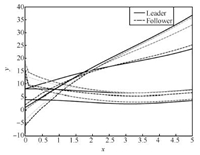
|
Download:
|
| Fig. 2. Trajectories of all the agents. | |
From the definition of sliding manifold,we have $\tilde{x}_1+\tilde{x}_2=0$,where $\tilde{x}_1=x_{1\mathcal{F}}+L_{\mathcal{F}\mathcal{F}}^{-1}L_{\mathcal{F}\mathcal{R}}x_{1\mathcal{R}}$ and $\tilde{x}_2=x_{2\mathcal{F}}+L_{\mathcal{F}\mathcal{F}}^{-1}L_{\mathcal{F}\mathcal{R}}x_{2\mathcal{R}}$. Fig. 3 shows the phase portrait under sliding mode control. Obviously,once the error trajectories exponentially reach the sliding surface in a finite time,the followers will converge to the convex hull spanned by the leaders asymptotically,i.e.,as $\tilde{x}_1\rightarrow 0$ and $\tilde{x}_2\rightarrow 0$, $x_{1\mathcal{F}}\rightarrow L_{\mathcal{F}\mathcal{F}}^{-1}L_{\mathcal{F}\mathcal{R}}x_{1\mathcal{R}}$ and $x_{2\mathcal{F}}\rightarrow L_{\mathcal{F}\mathcal{F}}^{-1}L_{\mathcal{F}\mathcal{R}}x_{2\mathcal{R}}$.
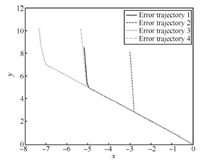
|
Download:
|
| Fig. 3. Phase portrait under sliding mode control. | |
Example 2. We consider a group of six agents with three leaders,namely,nodes 1$\sim$3,and three followers,namely,nodes 4$\sim$6. The interaction pattern is chosen as Fig. 4.
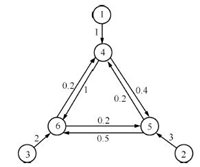
|
Download:
|
| Fig. 4. A directed graph with 3 leaders and 3 followers. | |
Suppose that the leaders and followers have the following dynamics:
| $\dot{x}_i=v_i,\\ \dot{v}_i=u_i,\ \ \ i=1,2,\cdots,6.$ |
From (11),we can obtain $P=\left[\begin{array}{ccc}\sqrt{3} 1 \\ 1 \sqrt{3}\end{array}\right]$. We choose $\alpha =0.01$ and $\beta=2$. The initial conditions are chosen as $x_0=[5;2;-5;2;4;2;-10;2;1;1;20;10]$ and $y_0=[5;2;-2;2;-5;2;-5;2;25;1;2;10]$. The simulation result using (12) for (4) with the time-varying control input $u_i=-\sin(t)$ ($i=1,2,3$) on the leaders is shown in Fig. 5,where the dotted lines are the trajectories of the leaders and the others are trajectories of the followers. It is obvious that the followers converge to the convex hull spanned by the the leaders in a finite time exponentially.
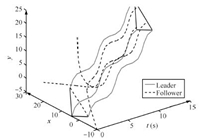
|
Download:
|
| Fig. 5. Trajectories of all the agents. | |
From the definition of sliding manifold defined in Section IV,we have $(\tilde{x},\tilde{y})=(0,0)$,where $\tilde{x}=x_{\mathcal{F}}+L_{\mathcal{F}\mathcal{F}}^{-1}L_{\mathcal{F}\mathcal{R}}x_{\mathcal{R}}$ and $\tilde{y}=y_{\mathcal{F}}+L_{\mathcal{F}\mathcal{F}}^{-1}L_{\mathcal{F}\mathcal{R}}y_{\mathcal{R}}$. Fig. 6 shows the phase portrait under sliding mode control. Obviously,as $\tilde{x} \rightarrow 0$ and $\tilde{y}\rightarrow 0$,$x_{\mathcal{F}}\rightarrow L_{\mathcal{F}\mathcal{F}}^{-1}L_{\mathcal{F}\mathcal{R}}x_{\mathcal{R}}$ and $y_{\mathcal{F}}\rightarrow L_{\mathcal{F}\mathcal{F}}^{-1}L_{\mathcal{F}\mathcal{R}}y_{\mathcal{R}}$, which means that the followers converge to the convex hull spanned by the leaders.
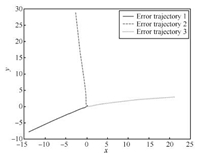
|
Download:
|
| Fig. 6. Phase portrait under sliding mode control. | |
In this paper,containment control problems of general linear multi-agent systems with multiple dynamic leaders have been investigated. The task is to make the followers converge to the convex hull spanned by the multiple dynamic leaders whose control inputs are nonzero and not available to any followers. Based on the relative states of neighboring agents,fast sliding mode controllers have been proposed for both cases of reduced order and non-reduced order. We have shown that the trajectories exponentially reach the sliding mode surfaces if for each follower there exists at least one of the leaders which has a directed path to the follower and the leaders' control inputs are bounded. We have found that the control Lyapunov function for exponential finite time stability is a useful tool to prove reachability of the sliding mode surface. Our future work will focus on discrete-time fast sliding mode control systems. In the future, more efforts will be made on the stochastic containment of general linear multi-agent systems by employing the stochastic approximation technique[40, 41].
| [1] | Pedersen J M, Patel A, Knudsen T P, Madsen O B. Applying 4-regular grid structures in large-scale access networks. Computer Communications, 2006, 29(9):1350-1362 |
| [2] | Chopra N, Spong M W. Bilateral teleoperation:an historical survey. Automatica, 2006, 42(12):2035-2057 |
| [3] | Nuño E, Basañez L, Ortega R. Passivity-based control for bilateral teleoperation:a tutorial. Automatica, 2011, 47(3):485-495 |
| [4] | Ye Y, Liu P X. Improving haptic feedback fidelity in wave-variable-based teleoperation oriented to telemedical applications. IEEE Transactions on Instrumentation and Measurement, 2009, 58(8):2847-2855 |
| [5] | Polushin I G, Liu P X, Lung C H. A control scheme for stable forcereflecting teleoperation over IP networks. IEEE Transactions on Systems, Man, and Cybernetics, Part B:Cybernetics, 2006, 36(4):930-939 |
| [6] | Polushin I G, Liu P X, Lung C H. Projection-based force reflection algorithm for stable bilateral teleoperation over networks. IEEE Transactions on Instrumentation and Measurement, 2008, 57(9):1854-1865 |
| [7] | Nuño E, Ortega R, Barabanov N, Basañez L. A globally stable PD controller for bilateral teleoperators. IEEE Transactions on Robotics, 2008, 24(3):753-758 |
| [8] | Hua C C, Liu P X. Teleoperation over the internet with/without velocity signal. IEEE Transactions on Instrumentation and Measurement, 2011, 60(1):4-13 |
| [9] | Nuño E, Basañez L, Ortega R, Spong M W. Position tracking for nonlinear teleoperators with variable time delay. International Journal of Robotics Research, 2009, 28(7):895-910 |
| [10] | Yang X, Hua C C, Yan J, Guan X P. New stability criteria for networked teleoperation system. Information Sciences, 2013, 233(1):244-254 |
| [11] | Yan J, Guan X P, Luo X Y, Yang X. Consensus and trajectory planning with input constraints for multi-agent systems. Acta Automatica Sinica, 2012, 38(7):1074-1082 |
| [12] | Lin Z Y, Broucke M, Francis B. Local control strategies for groups of mobile autonomous agents. IEEE Transactions on Automatic Control, 2004, 49(4):622-629 |
| [13] | Franchi A, Masone C, Büthoff H H, Robuffo P. Bilateral teleoperation of multiple UAVs with decentralized bearing-only formation control. In:Proceedings of the International Conference on Intelligent Robots and Systems. San Francisco, USA:IEEE, 2011. 2215-2222 |
| [14] | Xu Z H, Ma L, Wu Z Y, Schilling K, Necsulescu D. Teleoperating a formation of car-like rovers under time delays. In:Proceedings of the 30th Chinese Control Conference. Yantai, China:IEEE, 2011. 4095-4101 |
| [15] | Rodríguez-Seda E J, Troy J J, Erignac C A, Murray P, Stipanović D M, Spong M W. Bilateral teleoperation of multiple mobile agents:coordinated motion and collision avoidance. IEEE Transactions on Control Systems Technology, 2010, 18(4):984-992 |
| [16] | Kelly R, Santibáñez V, Loria A. Control of Robot Manipulators in Joint Space. London:Springer, 2005 |
| [17] | Fu M Y, Xie L H. The sector bound approach to quantized feedback control. IEEE Transactions on Automatic Control, 2005, 50(11):1698-1711 |
| [18] | Yang R N, Shi P, Liu G P, Gao H J. Network-based feedback control for systems with mixed delays based on quantization and dropout compensation. Automatica, 2011, 47(12):2805-2809 |
| [19] | Peng C, Tian Y C. Networked H∞ control of linear systems with state quantization. Information Sciences, 2007, 177(24):5763-5774 |
| [20] | Chun H Y, Fei S M, Yue D, Chen P, Sun J T. H∞ quantized control for nonlinear networked control systems. Fuzzy Sets and Systems, 2011, 174(1):99-113 |
 2014, Vol.1
2014, Vol.1 


